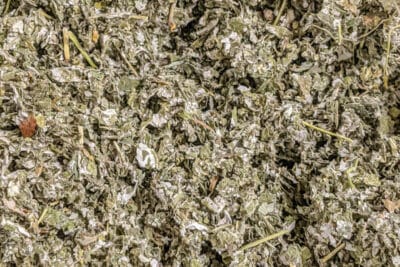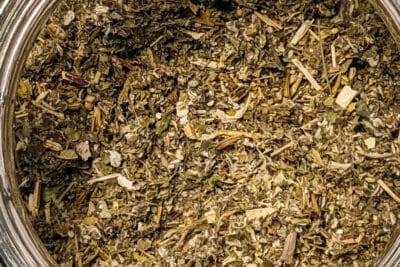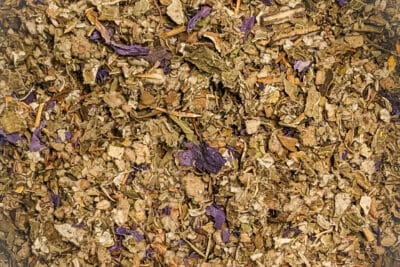Red Raspberry Leaves – Smooth Astringent Herb
Rubus idaeus
Also referred as:
Red raspberry leaves
🍃 Texture when dried
Smooth, fluffy & crumbly
👅 Taste
Astringent taste with hints of fruits
❔ Usage
Herbal tea, smoking blends ingredients and for potpourri
💨 Smoke
Moderate smoke
🗜 Harshness
Smooth
⚡ Effects
Relaxing and calming
Table of Contents
Introduction
Red raspberry leaves are a popular herbal remedy that come from the red raspberry plant (Rubus idaeus). These leaves are often dried and steeped as tea, or smoked as a natural alternative. Known for their pleasant flavor and aroma, red raspberry leaves have been used traditionally for various herbal purposes throughout history.
Smokably products with Red raspberry leaves :
-
 Raspberry LeavesCAD $8.00 – CAD $12.00
Raspberry LeavesCAD $8.00 – CAD $12.00 -
 Smokably Original Blend (Red raspberry)CAD $12.00 – CAD $18.00
Smokably Original Blend (Red raspberry)CAD $12.00 – CAD $18.00 -
 The Holy Blend ▸ Holy Basil, Blue Lotus, Red Raspberry, Mullein, Lemon BalmCAD $14.00 – CAD $20.00
The Holy Blend ▸ Holy Basil, Blue Lotus, Red Raspberry, Mullein, Lemon BalmCAD $14.00 – CAD $20.00
Frequently asked questions
Is it common to smoke Red raspberry leaves?
Yes, smoking red raspberry leaves is relatively common, especially among those seeking a natural alternative to tobacco and other smoking materials. The leaves produce a smooth, mild smoke when burned and do not contain nicotine, making them a popular choice for herbal smoking blends. However, it is essential to remember that inhaling any smoke carries inherent risks to lung health.
Is Red raspberry leaves smoked on its own or mixed with other herbs?
Red raspberry leaves can be smoked on their own, but they are often mixed with other herbs to create unique and flavorful herbal smoking blends. Common herbs combined with red raspberry leaves include damiana, mullein, lavender, chamomile, and mint, among others. Mixing with different herbs can provide diverse tastes, aromas, and experiences to cater to personal preferences while keeping the focus on natural ingredients.
Can Red raspberry leaves help you quit smoking?
While red raspberry leaves do not contain nicotine and are sometimes considered a natural alternative to tobacco, it’s important to note that there is no clinical evidence to support claims that smoking red raspberry leaves can help you quit smoking. However, some individuals choose to use herbal smoking blends, including red raspberry leaves, as part of their transition away from tobacco products. As with any smoking cessation method, the effectiveness will vary from person to person, and it’s always best to consult with a healthcare professional for personalized guidance.
Why do people enjoy Red raspberry leaves ?
People enjoy Red raspberry leaves for a variety of reasons.
- Pleasant flavor: Red raspberry leaves have a mild, tasty flavor, which makes them enjoyable in teas, tisanes, and smoking blends.
- Aroma: The leaves produce a soothing and calming aroma when steeped as tea or smoked, which many find appealing.
- Natural alternative: They are often used as a natural substitute for tobacco in smoking blends, as they do not contain nicotine and are less harmful than most commercial tobacco products.
- Traditional uses: Red raspberry leaves have been utilized for centuries in folk medicine and herbalism, contributing to relaxation and overall well-being, although no health claims should be made.
- Versatility: The leaves can be used in multiple ways, such as in teas, tinctures, and salves, or smoked as part of a herbal blend, offering different options for their consumption.
- Accessibility: Red raspberry leaves are easily found in many herbal stores, online shops, and even some farmers’ markets, making them accessible for those interested in trying them out.
NB. Anecdotal or historical claims should not be construed as health claims. Always consult a health specialist prior to oral consumption of any herb. Consumption of any herbs might have side effects.
How do you make a tea out of Red raspberry leaves ?
To make a herbal tea out of Red raspberry leaves, you can follow these simple steps:
- Gather the ingredients: You’ll need about 1-2 teaspoons of dried red raspberry leaves per cup of water. You can purchase them from health food stores, online, or even harvest them freshly from a raspberry plant, ensuring it hasn’t been treated with chemicals.
- Boil water: Heat a cup of water (approximately 240ml or 8 ounces) to the boiling point.
- Steep the leaves: Place the dried red raspberry leaves in a tea infuser or tea ball, and then put it into your teacup or mug. Pour the boiling water over the leaves, and let them steep for about 10-15 minutes. The longer the steeping time, the stronger the flavor and aroma.
- Remove the leaves: After the desired steeping time has passed, remove the infuser or tea ball from your teacup or mug.
- Sweeten (optional): If you prefer, you can sweeten your red raspberry leaf tea with a bit of honey, agave nectar, or your preferred sweetener.
- Enjoy: Sip the tea while it’s still warm, and savor the refreshing, mildly fruity taste of red raspberry leaves.
Remember that red raspberry leaf tea is best enjoyed in moderation, and it’s always wise to consult with a healthcare professional before adding new herbs to your routine, especially if you are pregnant, nursing, or have any health concerns.
What does Red raspberry leaves look like?
Red raspberry leaves are medium to dark green, with a slightly serrated edge along their borders. The leaves grow alternately on canes, arranged in an organized pattern along the stems. Each leaf has a distinct shape, featuring a rounded to slightly ovate form with a pointed tip. The leaves’ surface is coarse and textured, with visible veins creating a slightly ridged appearance, while their underside may appear lighter green and slightly fuzzy.
In contrast, the raspberry plant itself produces small white or light pink flowers, which later turn into the well-known and widely-consumed raspberry fruits. The raspberry bushes have woody stems, known as canes, which support the growth of these distinct leaves.
How has Red raspberry leaves been used historically?
Historically, red raspberry leaves have been used in various cultures for their herbal properties and versatility. Some traditional uses include:
1. Women’s health: Red raspberry leaves have a longstanding history in folk medicine for supporting women’s reproductive health, especially during pregnancy and childbirth.
2. Gastrointestinal support: The leaves were traditionally used in teas or infusions to help ease digestive discomfort and soothe the gastrointestinal system.
3. Respiratory well-being: Red raspberry leaf tea was believed to help alleviate respiratory issues in some traditional medicine systems, although no health claims can be made regarding their effectiveness.
4. Oral health: The leaves were sometimes used to make poultices or mouthwashes, aiming to support healthy gums and teeth.
5. Skin care: Red raspberry leaves were occasionally used in skin care remedies for soothing and nourishing purposes, often in the form of infused oils or creams.
6. Culinary uses: Red raspberry leaves were occasionally added to dishes as a flavoring agent or as a nutritious ingredient in various recipes.
While the historical uses of red raspberry leaves may be intriguing, it’s important to remember that no validated health claims can be made for their effectiveness. As with any herbal remedy, it’s wise to consult a healthcare professional before using red raspberry leaves, especially if you have any health concerns or are pregnant or nursing.



